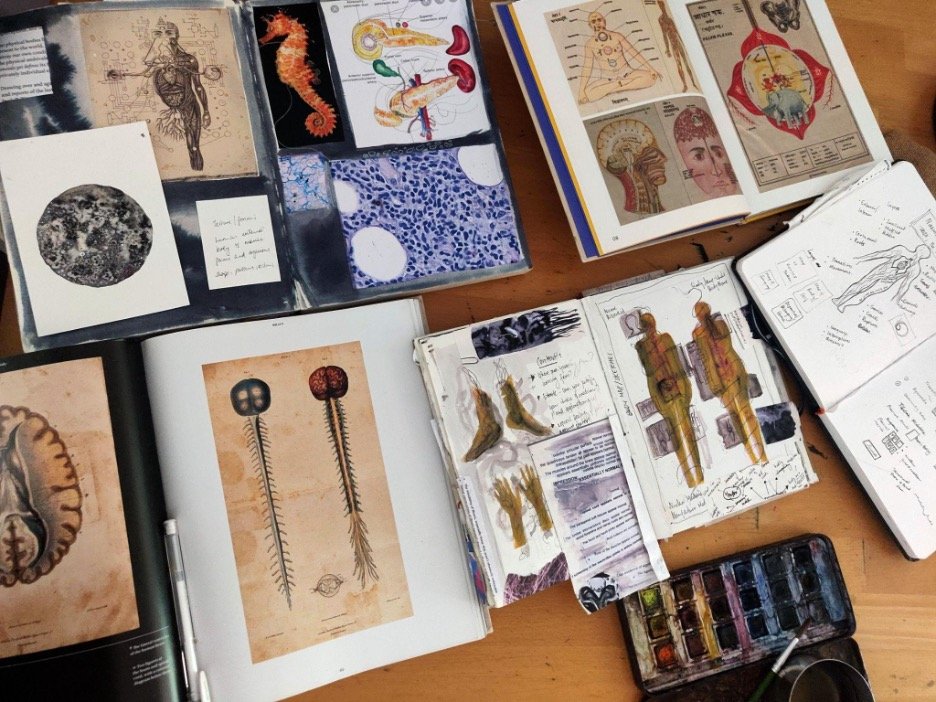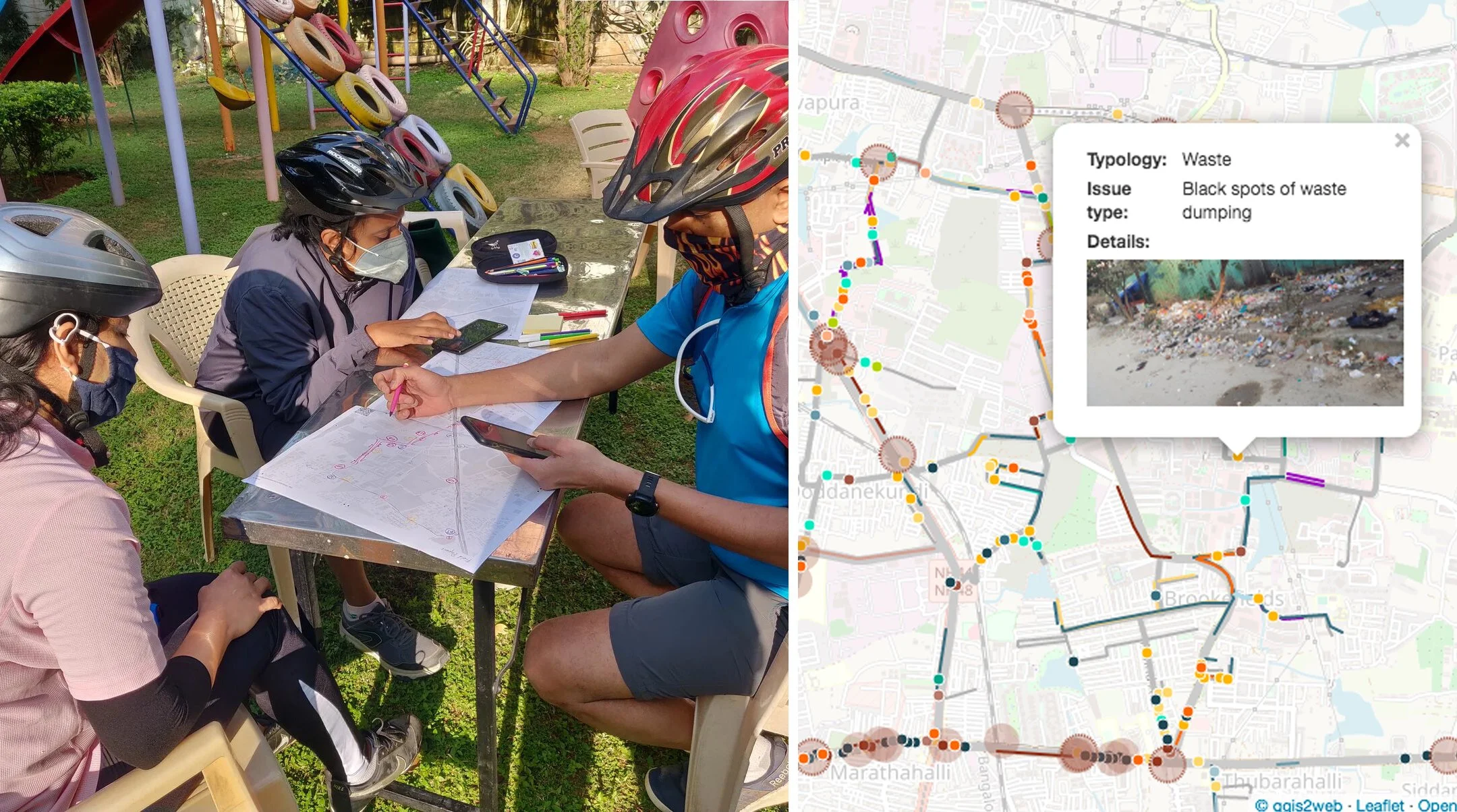Fine Art Awardee 2020: Devika Sundar
Devika Sundar is a 2020 Fine Art Awardee. In the blog below she reflects on her practice during the past year, offering snippets through different phases of digital residencies, access considerations and life as an artist during the lockdown.
Journal notes: in transit [ 2020 - 2021]
Incubating /May 2020/
Lockdown has been a shifting mix of feelings from claustrophobia to fear and uneasiness over what things mean for the months to come. Long afternoons spent burying in writing, scribbling and painting have been my source of relief through these weeks. While the studio feels the absence of others around, it has been a space of solace and sanity for me in these months. The boundaries of this time allow me to wrap myself in a little incubatory bubble, knowing I have the safety of a creative space and touchpoint to return to each evening.
These weeks, I find myself obsessively pacing and circling studio floors in odd insomniac hours of the night as I calm the swirling to-do lists in my head for the next day. On quieter afternoons, I scribble research notes and ideas, watching the passing, snuggled gloom and doom of Bangalore skies and rains on my terrace. Meetings and calls filter in the background while I paint and sculpt to keep my hands moving. Days spill slowly into another, as I strive to find unrushed spaces of comfort and presence within the ambiguity and uncertainty of where all this will lead.
Virtual Networks and channels / Dec 2020/
With physical restrictions pushing art further into digital spaces, it has been a curious process of creating and sharing practice over the small cube of Instagram in the last year. In some ways it has served as a little transitioning blog to share developing thoughts and notes, peeks into works in process, journal explorations and sketches, books I might be reading or ideas I might be mulling. Rather than shielding works from an audience until it reaches a physical exhibition space - creating and sharing virtually releases practice from the privacy of our studio walls, in ways that feel organic, impulsive, rough and freeing. The final form of a work is substituted with many little layers, behind the scenes and elements in between. It has been exciting to also have intimate windows into other artists' practices through following artist takeovers, discussions and workshops online.
Platforms like Instagram not only allow a space to exchange work and practice but also set up democratic forms of engagement and accessibility with pages like Art chain India , Carpe art, Open call India sharing a diversity of resources, information and opportunities that we might not have had access to earlier. As an artist, it becomes a refreshing, alternative space to start thinking towards possible peer structures, collectives and collaborations.
Journal Pages
Safe spaces and support structures /March 2021/
I am grateful to discover safe spaces and support systems through meeting others online - through peer exchanges, virtual residency afternoons, studio workshops, clubhouse rooms, zoom drawing parties and shared exercises. Digital residencies have allowed time and space to pause, recalibrate and reflect more deeply and internally without a pressure to produce or create.
In many ways this year has been isolating, and while virtual screens can feel confronting and limiting, it also gives me comforting meeting points to look forward to each day. Discussions, debates, workshops and feedback tether a sense of shared community, safety and trust; meeting rooms, exchanges and chatter take me away from my own practice, allowing me to escape circling loops in my own head.
Due to chronic illness and physical accessibility barriers, it has often been difficult for me in the past to attend and participate in events, talks, and exhibition openings. However, having the ability to access panels, workshops and events online in the last two years has been valuable. Being able to meet a diversity of people from the community through online spaces has led to possibilities and potential to form longer term offline connections.
While virtual spaces offer numerous networks, it can also become saturating and exhausting in excess. It has become increasingly important for me to disengage every once in a while, take extended breaks from my screen, rest my body, place healthy boundaries and return to practice in a mindful manner.
An ode to the balcony, Smarter digital Realities Residency [ Goethe institute Bangalore + Sandbox Collective ]
Access needs and systems / April 2021/
In July last year, Marg Magazine asked me to think through a piece for their June 2021 issue: Designing A Brave New Era - exploring art, disability and accessibility, against the background of the pandemic and the past year. Attempting to reflect and navigate these thoughts has been a confusing and vulnerable process. Trying to edit and finish the piece through the peak of the second wave has felt difficult and uneasy to comprehend and process.
However researching, articulating and educating myself around the lack of disabled accessibility in art spaces and the need for more inclusive systems and structures of participation has been eye opening. This is not only limited to the necessity for physical accessibility and infrastructural accommodations in galleries, residency spaces, festivals and biennials, but for us as artists to move beyond exclusivist, ableist or tokenized formats and instead consciously create multi sensorial works for a diversity of bodies and audiences. With the virus posing a fear and threat of disability and illness to larger sections of our population, pushes the urgency for more sustainable, sensitive and supportive spaces - where access is not seen as an afterthought but a deliberate and essential need.
Winding down /Nov 2021/
Spending 2020 -2021 primarily in lockdown, has given me extended space to reconnect with myself, journal more, rewind to earlier jottings, photographs, drawings and memories and reflect on half worked through thoughts and ideas I might have forgotten or discarded. It has been meaningful to have the breathing space to reflect and reevaluate at different points in my practice in the last two years; to pause and break, reserve mindful check-ins, create conscious escapes, and allow blurred lines to spill vulnerably between personal and creative spaces.
Through the last year, over multiple zoom calls and virtual meetings, I have been collaborating with Studio Slip, a spatial design studio headed by Kamini Rao - towards a proposed Archives exhibit with The National Centre of Biological Sciences ( NCBS), Bangalore. In our project, 'Bodies at Sea', we trace boundaries around the hidden and unknown, exploring an unusual synergy between our interior bodies against oceanic bodies of the deep sea. The project has allowed me to personally think through a lot of swimming thoughts over the last year, interweaving them into ideas, practices, voices, writings and archives collected from different parts of the internet and world.
Over this month, I have been grateful to engage with artists from both India and Wales, as part of the Project MAAF (Manifesto For Accessible Art) digital residency -a collaborative, bipartite project that explores disability access barriers, possibilities and needs within art spaces in both countries. Together, we have been working on a manifesto that attempts to reflect, propose and design change towards an all inclusive, accessible art festival.
Bodies at sea, Research and explorations
In Transit / Dec 2021/
Flipping through journal pages from 2019, I suddenly remember the discomfort of feeling unable to return to material practice and work; in desiring space and reclusiveness to create, while balancing circles of exchange, meeting and connection. I have been shifting though some of these thoughts lately. While I do value the quiet insularity, introspection and space this unsettling period of incubation has given us, I look forward to the tangibility and movement of responding and creating freely alongside each other, whenever all this ends.















